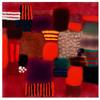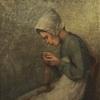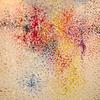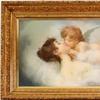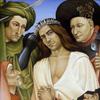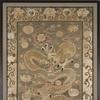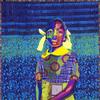Baltimore Museum of Art Diversifies Its Collections With 70 Acquisitions, From Historic to Contemporary Artists
- BALTIMORE, Maryland
- /
- August 07, 2019
The Baltimore Museum of Art (BMA) announced earlier this summer that it has added to its collection this year more than 70 historic and contemporary works by a range of national and international artists. Among the new acquisitions are 17 objects purchased with proceeds from the auction of recently deaccessioned works. These include mixed-media works by Charles Gaines, Ebony G. Patterson, and Wilmer Wilson IV; prints by Emma Amos, Geta Brătescu, and Faith Ringgold; drawings by David Driskell and Clio
Newton; a film by Ana Mendieta; photography by Elle Pérez; and a painting by Mary Lovelace O’Neal, among others. The BMA, through gift and purchase, has also acquired a
range of historic works, including a rare 18th-century miniature by Anna Maria Werner; 19th-century prints by Manuel Orazi; and a 20th-century painting by André Derain and
drawing by Édouard Vuillard.
“This newest group of acquisitions highlights the incredible vision of the BMA’s new curatorial team to establish important connections across artists and movements within the museum’s collection,” said Christopher Bedford, BMA Dorothy Wagner Wallis Director. “These historic and contemporary works create new opportunities to tell important and relevant narratives about the development of art and culture, and represent our collective goal to capture the innovations of a broad spectrum of artists with a continued and particular emphasis on those that have previously been under-represented in institutional collections.”
In spring 2018, the BMA deaccessioned seven works that represented redundancies within its contemporary holdings. The proceeds from the sale of these works are being used to purchase new works of art, produced from 1943 to the present day. New acquisitions are chosen with the vision to strengthen the scope and depth of the museum’s
collection, allowing it to tell a more fulsome story on the development of contemporary art. Today’s announcement marks the third group of works to come into the BMA’s collections with funds from the deaccession. Among the previous acquisitions are works by Njideka Akunyili Crosby, Zanele Muholi, Wangechi Mutu, Senga Nengudi, Trevor
Paglen, Mary Reid Kelley, Amy Sherald, Carrie Mae Weems, Jack Whitten, and Lynette Yiadom-Boakye.
Highlights of the most recent acquisitions are:
● Geta Brătescu, Mutter Courage (Mother Courage) (1966): Throughout her long career, Geta Brătescu (Romanian, 1926–2018) produced a wide range of drawings, collages, textiles, photographs, experimental films, and performances. Among the artist’s earliest extant works, this rare suite of four drypoints remained in the artist’s studio for decades. The prints represent scenes from Bertolt Brecht’s 1939 play Mother Courage and Her Children, which is widely recognized as the greatest anti-war play of all time. Produced entirely in drypoint—an etching technique that yields rich, velvety lines—the suite highlights Brătescu’s artistic mastery as well as her humanist outlook. This is the first set of works by the artist to enter the BMA collection.
● Charles Gaines, Numbers and Trees, Tiergarden Series 3 (2018): Charles Gaines (American, b. 1944) is recognized as an innovator within American conceptual art movements. Numbers and Trees, Tiergarden Series 3 (2018) is a recent body of work that stems from an idea that Gaines first began exploring in the 1970s. For the project, Gaines photographs and sequentially diagrams trees—in this case from Berlin’s Tiergarden, the city’s largest urban park. The four images entering the collection were printed progressively by layering successive plates, one on top of the other, to create a prismatic array of color. These works are the first by Gaines to enter the BMA collection.
● Ana Mendieta, Blood Inside Outside (1975): Ana Mendieta’s (Cuban-American, 1948–1985) practice included drawing, print-making, performance, sculpture, and film, and has proven foundational to the development of art focused on identity, politics, and experimental media. Mendieta often placed her own body at the center of her work and blood served as one of her frequent motifs. In this silent super-8 mm color film transferred to high-definition digital media, she stands on the bank of Old Man’s Creek in Iowa, dipping her hands into a vessel containing blood which she then rubs across her body, suggesting rich and layered meanings from notions of female fertility to the violence often inflicted on the female body. The film—the first work by Mendieta to enter the BMA’s collection—was remastered by the artist’s estate and made available as part of a renewed effort to bring greater attention to the importance of her work.
● Mary Lovelace O'Neal, Running Freed More Slaves Than Lincoln Ever Did (1995): Mary Lovelace O’Neal (American, b. 1942) creates paintings that defy categorization, sitting at the intersection of abstraction and figuration, individual expression, and social content. Her work incorporates rich materiality, brilliant color, and free-form gesture, evoking the body in motion as both maker and subject. This painting is a superb example of O’Neal’s work from the 1990s, when her titles often referenced America’s long history of slavery and racism. It is the first work by the artist to enter the BMA’s collection. Running Freed expands the story of postwar gestural painting as told by the BMA’s collection, establishing O’Neal’s position as a critical voice in the art historical canon.
• Ebony G. Patterson, ...we lost...for those who bear/bare witness (2018): Ebony G. Patterson’s (Jamaican, b. 1981) multidisciplinary practice spans tapestry, collage, sculpture, installation, photography, video, and performance. Patterson uses beauty as a tool—drawing viewers in with dazzling colors and opulent surfaces—to reflect on social injustice, violence, and the indifference often shown to the lives of people disenfranchised by systems of race and class. This monumental hand-cut-paper work belongs to a series in which Patterson implicates viewers in grieving and bearing collective responsibility for victims of violent crimes. Its garden imagery evokes life’s potential to flourish as well as to decay, symbolizing the grave where bodies are buried, as well as a paradise where those lost can be honored and remembered. This is the first work by Patterson to enter the BMA’s collection.
In addition to its expansion of its contemporary holdings, the BMA continues to collect important works of historic art that capture the trajectory of creative innovation through time and across culture and geography. These works have been accessioned into the collection as purchases made with endowment funds and as gifts to the institution.
Highlights from the most recent grouping of historic works include:
• André Derain, Paysage de Provence (Le Petit Pont) (1930–31): One of the founders of the Fauvist movement, André Derain (French, 1880–1954) had a long and successful career that included several artistic styles. In this beautifully balanced and stylized composition, the artist has contrasted the earth tones of the ground, stream, and bridge with the rich greens of the foliage, the vibrant blue sky, and the purple and blue mountains. This painting was originally part of modern art patron Paul Guillaume’s esteemed collection, some of which was donated to the Musée de l’Orangerie in Paris. This brilliant landscape adds depth to the museum’s renowned collection of European modernist paintings.
• Manuel Orazi, Magic Calendar (1895): This exceptionally rare calendar embodies some of the most fascinating aspects of the Decadent and Symbolist movements of the late 19th-century. Commissioned by the esoteric Art Nouveau gallerist Siegfried Bing, Manuel Orazi (Italian, 1860–1934) drew upon mystical and astrological texts composed by French folklorist and food writer Austin de Croze for his eroticized and bizarre illustrations of all things occult in the calendar year 1896. Though originally conceived as an edition of 777, it was likely only realized in a run of 30–40. Today, only 13 complete copies are known, a handful of which are in public collections.
• Joseph Pennell, A Typical Bethnal Green Street (c. 1900): A native of Philadelphia, Joseph Pennell (American, 1857–1926) moved to England in 1884, where he worked as a book illustrator. He was acclaimed for his portrayals of architectural sites and street scenes, which were frequently published in leading magazines of the day. A Typical Bethnal Green Street captures the working-class housing in the East End of London and was among illustrations that Pennell provided for Walter Besant’s book East London (1901), which attempted to draw attention to the plight of the poor. This is the first drawing by the artist to enter the BMA’s collection.
• Édouard Vuillard, The Bay (c. 1912): Edouard Vuillard (French, 1868–1940) is best known for his figural works and intimate scenes of everyday life. However, in the early 20th century, Vuillard began turning away from his heavily patterned interiors and increasingly painted outdoor views. The Bay represents the artist’s return to naturalism, and was likely painted en plein air during his travels to Brittany and Normandy. Depicting a mother and child walking along the water’s edge, the painting encapsulates Vuillard’s articulation of light and signature use of bright and bold color. This is the first work on paper using distemper by the artist in the collection.
• Anna Maria Werner, Mausolus and Artemisia (1709): Throughout her life, Anna Maria Werner (German, 1688–1753) was an active miniaturist and art teacher. She also likely created designs for a range of engraved portraits and landscape views, and may have even worked as a printmaker herself. Mausolus and Artemisia is a signed and dated gouache on parchment that is stretched over a copper plate. Jewel-like in its small scale and brilliant in its color, the work is considered exceptionally rare for its incredibly good condition. The exquisitely produced work stands as a testament to Werner’s talent. It is also the first example of a miniature drawing to enter the BMA’s collection.




